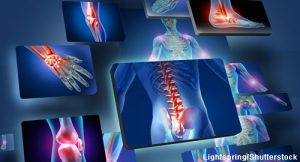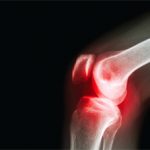 EULAR 2021—Although osteoarthritis (OA) is the most common form of arthritis, advances in its treatment have been few and far between. During EULAR 2021, Xavier Chevalier, MD, professor of rheumatology at Paris University XII and head of the Rheumatology Department at Henri Mondor Hospital, Créteil, France, provided an excellent overview of what’s new and interesting in the field of OA.
EULAR 2021—Although osteoarthritis (OA) is the most common form of arthritis, advances in its treatment have been few and far between. During EULAR 2021, Xavier Chevalier, MD, professor of rheumatology at Paris University XII and head of the Rheumatology Department at Henri Mondor Hospital, Créteil, France, provided an excellent overview of what’s new and interesting in the field of OA.
Non-Pharmacologic Treatments
Dr. Chevalier began his presentation by asking: Is non-pharmacologic management sufficient to treat OA? A study from Reichenbach et al. assessed the impact of individually calibrated biomechanical footwear therapy on improving pain and physical function in patients with symptomatic knee OA. A total of 220 patients were randomized to receive and wear shoes with individually adjustable, external, convex pods attached to the outsole or a sham model of this shoe style with visible, nonadjustable outsole pods that did not create a convex walking surface. The study’s primary outcome was the change in knee pain at 24 weeks of follow-up as assessed by the Western Ontario and McMaster Universities Osteoarthritis Index (WOMAC) pain subscore.1
In this study, patients in the intervention group saw their WOMAC pain subscore improve from 4.3 to 1.3, while patients in the placebo group saw a subscore change from 4.0 to 2.6, translating to a between-group difference of –1.3 (95% confidence interval [CI], –1.8 to –0.9; P<0.001). Although this difference was statistically significant, Dr. Chevalier noted the clinical importance of these findings is not entirely clear.
The next question: Do adaptations in types of exercise improve knee OA? A study by Allen et al. described the use of a stepped exercise program for patients with knee OA (STEP-KOA). The STEP-KOA intervention began with three months of an internet-based exercise program, followed by three months of biweekly, physical activity coaching calls and, finally, in-person physical therapy visits. Patients who did not meet the response criteria for improvement in pain and function at each step were guided into the subsequent step in therapy. This intervention group was compared with a control group that received written arthritis educational materials by mail.2
At nine months of follow-up, the estimated improvement of WOMAC total score was –5.5 points in the STEP-KOA group and 1.4 in the arthritis education group, with an estimated mean difference of -6.8 between groups (95% CI, –10.5 to –3.2; P<0.0003). Similar to the first trial he described, Dr. Chevalier explained the inter-group difference in WOMAC scores was statistically significant, but modest overall.
Patients often ask about supplements, such as glucosamine & turmeric, & dietary interventions & the role they may play in management of OA, said Dr. Chevalier.
Supplements
In terms of pharmacologic therapies for OA, Dr. Chevalier noted one study from 2020 reported an association of regular glucosamine use with lower mortality, including all-cause, cardiovascular, cancer, respiratory and gastrointestinal mortality measurements. The biologic mechanism that may explain this association is inhibition of nuclear factor-κB, which may reduce inflammation and trigger a response similar to that seen with a low-carbohydrate diet in animal models.3
In this observational study, residual, unmeasured confounders may explain the apparent association between glucosamine use and reduced mortality. Example: Patients taking regular glucosamine supplements may be more likely to engage in other beneficial health-related behaviors than those patients not regularly taking glucosamine supplements. Thus, glucosamine use may simply be a surrogate marker for healthy behaviors that affect mortality.
Dr. Chevalier noted patients often ask about other supplements and dietary interventions and the role these entities may play in management of OA. One of the most frequently discussed alternative therapies is turmeric, a spice that comes from the Curcuma longa plant.
In a randomized, double-blind, placebo-controlled trial of 70 patients with symptomatic knee OA and effusion synovitis as identified by ultrasound, two capsules of Curcuma longa extract were given daily to the intervention group for 12 weeks. The two primary outcomes of the study were changes in knee pain on a visual analog scale (VAS) and effusion synovitis volume assessed by magnetic resonance imaging (MRI).4
At 12 weeks, the intervention group improved the VAS pain score by –9.1 mm (95% CI, –17.8 to –0.4 mm; P=0.039) by comparison to the placebo group. However, the between-group change in effusion synovitis volume as assessed by MRI was 3.2 mL (95% CI, –0.3 to 6.8; P=0.075), which was not statistically significant. These results may indicate some symptomatic benefit may be accrued with the turmeric use, but longer follow-up may be necessary to detect any improvement in objective measures of knee effusion or synovitis.
Hand OA can be a particularly debilitating and difficult-to-treat condition. Thus, it’s helpful to understand if existing treatments for other forms of arthritis are worthwhile to try in patients with this condition.
On this note, Dr. Chevalier referenced a study by Davis et al., which investigated the effect of 1 mg of daily colchicine vs. placebo on hand pain and function for 12 weeks in older patients (aged 48–79 years) with hand OA. A total of 64 patients were enrolled and randomized to receive colchicine or placebo. The primary outcome was the VAS hand pain score, and secondary outcomes were tender and swollen joint count, grip strength, C-reactive protein level, Michigan Hand Outcomes Questionnaire total, function and pain scores. Unfortunately, no statistically significant differences were seen between the intervention and control groups for any of the primary or secondary outcomes.5 These disappointing results indicate the quest continues to find effective therapies for the management of hand OA.
The Future
What is on the horizon for OA treatment? Nerve growth factor (NGF) inhibitors are certainly an interesting area of future research. NGF plays a critical role in pain modulation and, thus, represents a potential therapeutic target in the treatment of OA. Additionally, sprifermin, a recombinant human fibroblast growth factor 18, is currently under investigation as a potential disease-modifying medication for OA.
With regard to medications that have bone-related actions and may provide potential treatment for OA, Dr. Chevalier mentioned two such therapies. The first are molecules that target the Wnt signaling pathway, which appears to be important in regulating and activating cellular and molecular processes during OA development. The second are cathepsin K inhibitors, which seem to have beneficial effects on bone and cartilage in preclinical OA models. Each of these novel therapies holds potential for the treatment of OA, but Dr. Chevalier explained many more studies are needed to truly prove efficacy.
Jason Liebowitz, MD, completed his fellowship in rheumatology at Johns Hopkins University, Baltimore, where he also earned his medical degree. He is currently in practice with Skylands Medical Group, N.J.
References
- Reichenbach S, Felson DT, Hincapié CA, et al. Effect of biomechanical footwear on knee pain in people with knee osteoarthritis: The BIOTOK randomized clinical trial. JAMA. 2020 May 12;323(18):1802–1812.
- Allen KD, Woolson S, Hoenig HM, et al. Stepped exercise program for patients with knee osteoarthritis: A randomized controlled trial. Ann Intern Med. 2021 Mar;174(3):298–307.
- Li ZH, Gao X, Chung VC, et al. Associations of regular glucosamine use with all-cause and cause-specific mortality: A large prospective cohort study. Ann Rheum Dis. 2020 Jun;79(6):829–836.
- Wang Z, Jones G, Winzenberg T, et al. Effectiveness of Curcuma longa extract for the treatment of symptoms and effusion-synovitis of knee osteoarthritis: A randomized trial. Ann Intern Med. 2020 Dec 1;173(11):861–869.
- Davis CR, Ruediger CD, Dyer KA, et al. Colchicine is not effective for reducing osteoarthritic hand pain compared to placebo: A randomised, placebo-controlled trial (COLAH). Osteoarthritis Cartilage. 2021 Feb;29(2):208–214.

